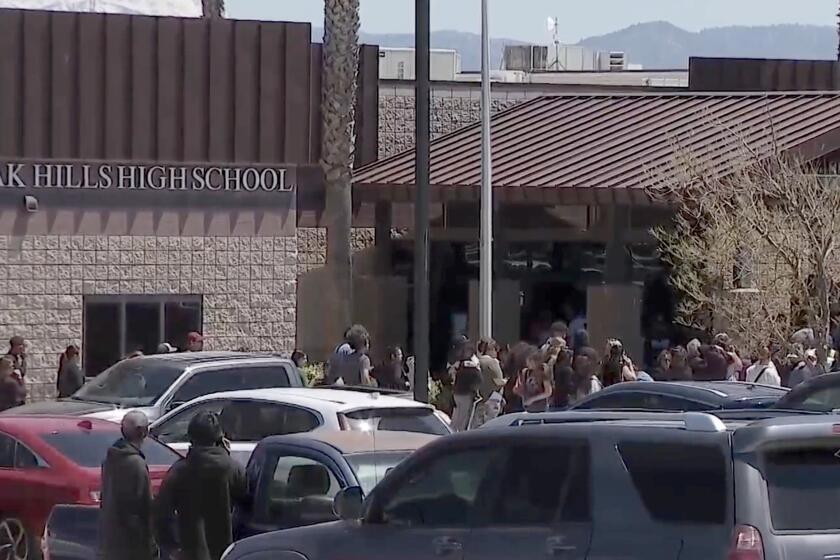Indian weddings, Southland-style
The bride was Mexican. The groom was Iranian.
Vanessa Domenech of Best Dream Weddings brought in mariachis and belly dancers.
The Woodland Hills wedding planner has done Latin weddings and Filipino weddings. She’d like to try her hand at Chinese ones. And although she’s planned Sikh nuptials, she has yet to do Hindu — which is why she signed up for “Indian Weddings 101.”
CITY BEAT: More stories from the city
Knowledge of white dresses and waltzes may be all you need in some places. In the Southern California wedding business, it will only get you so far.
The seminar held on a recent evening was organized by a nuptial clearinghouse in the heart of Little India, and it promised to open up new worlds.
Wedding Store 24 had assembled a parade of speakers to break down Hindu and Muslim ceremonies, bridal henna, Bollywood music and South Asian etiquette dos and don’ts.
More than 100 people — including regulars on the Indian wedding circuit — came to learn, find business and mingle.
As they arrived at the grand old Ebell of Los Angeles club, they were greeted outside by a white horse adorned in bejeweled cloth, ready for an Indian groom to ride to his wedding ceremony. Magnolia’s owner, Enchanted Carriages of Moorpark, serves the South Asian market as well as those looking for horse-drawn Victorian carriages and pumpkin-shaped Cinderella coaches.
During drinks in the art salon, two musicians (who were not Indian) sat lotus-style on a platform, playing tabla and Indian slide guitar.
Domenech swapped stories with photographer Karina Pires, who told her about the wedding of a Chinese bride and an Indian groom — how in the Hindu rites, the bride stepped on seven symbolic piles of rice and then, in Chinese tradition, she served tea to her parents and new in-laws.
After drinks came a buffet dinner in the Ebell’s enormous lounge, where a multiethnic troupe of sparkly Bollywood dancers swirled and spun up and down a staircase. Placards explained the contents of each chafing dish — nan, aloo gobi, gulab jamun — although one older attendee was not sufficiently assured to keep from telling people that she’d brought Alka Seltzer.
More Bollywood dancing followed (perhaps to accelerate digestion and boost energy) before the main work of the evening got underway.
In the club’s formal dining room, a handbook chock-full of Indian wedding terminology had been placed on each seat. Speakers started with the basics: the Indian subcontinent is huge and diverse, Hinduism is a religion and Muslims don’t eat pork. Then they moved on to the finer points of Indian weddings, including the Hindu baraat (the groom’s processional on horse, elephant or by car), the Muslim nikkah (religious contract) and the popularity of such symbols as peacocks and mangoes in mehndi (the henna decoratively applied to the bride’s hands and feet).
A Japanese American specialist in South Asian weddings described the jai mala, or flower garlands, that Hindu brides and grooms place around each other’s necks. A deejay went over the basics of beloved Bollywood numbers (reception staples) in which the onscreen lovers never kiss and always sing in the rain.
And all the experts told attendees to be prepared for very large and lavish gatherings, often with some 500 guests. Know that an Indian wedding celebration typically stretches on for days, and that it’s not just the couple that plans it but often many other family members. A stationery designer, to save others from her own steep learning curve, offered a chart of helpful acronyms: BOG for brother of the groom, UOB for uncle of the bride.
A Muslim planner advised women working on Muslim weddings not to be “too touchy,” especially with the men. If a man nods, she said, just nod back, don’t try to shake hands or “initiate.”
One rule seemed to run through all the rules, however: This being Southern California, almost no rule is set in stone.
Although a red wedding sari might be traditional, many Indian brides now opt for white dresses, they said. And while in a very special part of the Hindu wedding the groom ties a necklace, called a mangal sutra, around his bride’s neck, modern brides often also want a ring exchange.
Saadia Kibriya, the Muslim planner and owner of Kismet Events in Fullerton, said her mostly American-born, second-generation brides want fusion — something old from the worlds of their parents, something new from their own point of view.
“People are taking that freedom and liberty and changing up,” she said.
So stay tuned for Indian Weddings 202.
Follow City Beat @latimescitybeat on Twitter and at Los Angeles Times City Beat on Facebook.
More to Read
Start your day right
Sign up for Essential California for news, features and recommendations from the L.A. Times and beyond in your inbox six days a week.
You may occasionally receive promotional content from the Los Angeles Times.







